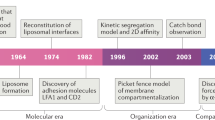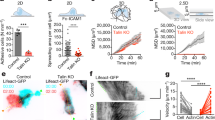Abstract
PROTEINS with an affinity for air–water interfaces may also show an affinity for hydrophobic sites in cell membranes. In exploring the basis for recognition in leukocyte chemotaxis, I and my colleagues have previously reported that proteins which excite a locomotor response in leukocytes do so by virtue of their possession of externally positioned nonpolar groups1–3. A protein may possess such groups either because it has become denatured, because nonpolar groups have been conjugated to it, or because, like αs- or β-caseins, its intrinsic content of nonpolar residues is too high for them all to be packed internally4. These proteins would be expected to be surface active and could possibly penetrate the phospholipid bilayer of a leukocyte to activate the cell for chemotaxis in a way that a more hydrophilic protein could not. This paper presents evidence that the surface activity and the chemotactic activity of proteins are indeed related, and that the chemotactic response of the leukocyte can be modified using membrane-active enzymes such as phospholipase A. These findings support the suggestion that chemotactic factors interact with the phospholipid bilayer of the cell membrane.
This is a preview of subscription content, access via your institution
Access options
Subscribe to this journal
Receive 51 print issues and online access
$199.00 per year
only $3.90 per issue
Buy this article
- Purchase on Springer Link
- Instant access to full article PDF
Prices may be subject to local taxes which are calculated during checkout
Similar content being viewed by others
References
Wilkinson, P. C., and McKay, I. C., Int. Archs Allergy appl. Immun., 41, 237–247 (1971).
Wilkinson, P. C., and McKay, I. C., Eur. J. Immun., 2, 570–577 (1972).
Wilkinson, P. C., Nature, 244, 512–513 (1973).
Waugh, D. F., Creamer, L. K., Slattery, C., and Dresdner, G. W., Biochemistry, 9, 786–795 (1970).
Zigmond, S. H., and Hirsch, J. G., J. exp. Med., 137, 387–410 (1973).
Wilkinson, P. C., in Primitive sensory and communication systems: the Taxes and Tropisms of Microorganisms and Cells (edit. by Carlile, M. J.) (Academic Press, New York, in the press).
Sessa, G., Freer, J. H., Colacicco, G., and Weissmann, G., J. biol. Chem., 244, 3575–3582 (1969).
Shipolini, R. A., Callewaert, G. L., Cottrell, R. C., Doonan, S., Vernon, C. A., and Banks, B. E. C., Eur. J. Biochem., 20, 459–468 (1971).
Condrea, E., de Vries, A., and Mager, J., Biochim. biophys. Acta, 84, 60–73 (1964).
Klibansky, C., London, Y., Frenkel, A., and de Vries, A., Biochim. biophys. Acta, 150, 15–23 (1968).
van Oss, C. J., and Gillman, C. F., J. reticuloendothel. Soc., 12, 283–292 (1972).
Thrasher, S. G., Yoshida, T., van Oss, C. J., Cohen, S., and Rose, N. R., J. Immun., 110, 321–326 (1973).
Author information
Authors and Affiliations
Rights and permissions
About this article
Cite this article
WILKINSON, P. Surface and cell membrane activities of leukocyte chemotactic factors. Nature 251, 58–60 (1974). https://doi.org/10.1038/251058a0
Received:
Issue Date:
DOI: https://doi.org/10.1038/251058a0
This article is cited by
-
Biocompatibility considerations at stimulating electrode interfaces
Annals of Biomedical Engineering (1992)
-
Chemotaxis of rat peritoneal macrophages induced by rat bone powder
Journal of Bone and Mineral Metabolism (1988)
-
Inhibition of leukocyte locomotion and chemotaxis by lipid-specific bacterial toxins
Nature (1975)
Comments
By submitting a comment you agree to abide by our Terms and Community Guidelines. If you find something abusive or that does not comply with our terms or guidelines please flag it as inappropriate.



